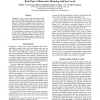123
Voted
AAAI
2012
13 years 3 months ago
2012
Planning is vital to a wide range of domains, including robotics, military strategy, logistics, itinerary generation and more, that both humans and computers find difficult. Col...
135
click to vote
AGI
2011
14 years 4 months ago
2011
We present an actor-critic scheme for reinforcement learning in complex domains. The main contribution is to show that planning and I/O dynamics can be separated such that an intra...
118
Voted
ICTAI
2009
IEEE
14 years 10 months ago
2009
IEEE
We introduce TiMDPpoly, an algorithm designed to solve planning problems with durative actions, under probabilistic uncertainty, in a non-stationary, continuous-time context. Miss...
133
click to vote
INFORMATICALT
2007
15 years 18 days ago
2007
A modified version of the Bellare and Rogaway (1993) adversarial model is encoded using Asynchronous Product Automata (APA). A model checker tool, Simple Homomorphism Verificatio...
112
Voted
JAIR
2006
15 years 20 days ago
2006
In this paper, we present the partitioning of mutual-exclusion (mutex) constraints in temporal planning problems and its implementation in the SGPlan4 planner. Based on the strong...
129
Voted
JAIR
2008
15 years 21 days ago
2008
Probabilistic planning problems are typically modeled as a Markov Decision Process (MDP). MDPs, while an otherwise expressive model, allow only for sequential, non-durative action...
113
Voted
ENDM
2006
15 years 21 days ago
2006
We consider a dynamic planning problem for paratransit transportation. The focus is on a decision to take one day ahead: which requests to serve with own vehicles, and which reque...
122
Voted
AI
2010
Springer
15 years 25 days ago
2010
Springer
Case-based planning can take advantage of former problem-solving experiences by storing in a plan library previously generated plans that can be reused to solve similar planning p...
99
Voted
ECAI
2010
Springer
15 years 1 months ago
2010
Springer
Landmarks for a planning problem are subgoals that are necessarily made true at some point in the execution of any plan. Since verifying that a fact is a landmark is PSPACE-complet...
114
Voted
AIPS
2000
15 years 2 months ago
2000
We describe in this paper a new method for extracting knowledge on Hierarchical Task-Network (HTN) planning problems for speeding up the search. This knowledge is gathered by prop...


